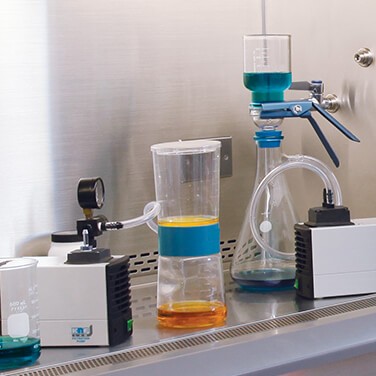Examining the Costs and Environmental Impact of Water Aspirators
Water Aspirators are a common way to create a low-strength vacuum for many standard laboratory applications. Their simple design employs water running through a narrowing tube to create a reduced pressure via the Venturi effect. The pump’s performance is dependent upon the temperature and pressure of the water, two variables that often change based on the number of users and the ambient temperature, resulting in an unreliable vacuum source. In addition, when being used in chemistry and biology labs, aspirators allow potentially hazardous solvents to mix into the water stream and flow down the drain. Because a stream of continuously running water is required to operate the pump, a significant amount of water is wasted. The cost of water coupled with the environmental impact of wasted water and solvent pollution need to be considered.
Waste and Cost
With growing pressures due to drought conditions and water shortages throughout the United States, restrictions on water usage are tightening and the cost of water is steadily increasing, with a 33% rise in recent years. An average aspirator pump uses at least 50,000 gallons per year (see “Thirsty Aspirators“ section). Besides the sheer waste this represents, in the U.S. this amount of water costs nearly $200 to $1,500. Growing restrictions and increasing water prices ensure that the cost of operating a water aspirator will grow even more expensive and will likely gain greater regulatory scrutiny in the future.
Environment
Handling potentially hazardous solvents is a normal part of common laboratory practices in chemistry and biology labs. Special care must be taken to prevent solvents and solvent vapors from being released into the environment. By design, water aspirators are susceptible to exposing solvents to the water stream and subsequent discharge into the drain. This may cause violations of existing environmental protection laws leading to fines and legal ramifications. While many have turned a blind eye to these types of releases in the past, the cumulative effects are witnessed by waste water treatment facilities and environmental testing agencies.
Performance
Due to the limitation of their end vacuum and flow performance, water aspirators are utilized for low-strength vacuum applications. The pump’s end vacuum and flowrate are dependent on the water temperature and pressure. Variations in the number of open faucets, the ambient temperature/season, and a host of other issues affecting the water supply can negatively impact the pump’s performance and consequently the quality and speed of the work being produced.
The Solution
While the upfront purchase price and ease of use of water aspirators may make them appear to be an attractive option for low-strength vacuum applications, the hidden costs of ownership are significant and growing. As the price of water increases and the restrictions on water usage and environmental protections tighten, water aspirators become more of a liability than an asset. Simple and cheap has become limited and expensive to operate.
Other pump technologies are better suited to provide consistent vacuum performance at an economical price while being in line with growing environmental initiatives. Alternatives like oil-free diaphragm pumps offer deeper end vacuum capabilities and higher flowrates, minimal operating cost, and economical purchase price. In fact, operating cost savings realized by replacing a single water aspirator will quickly offset the up-front and monthly power costs of switching to an oil-free diaphragm filtration pump, leading to a quick payback period — often less than one year.
THIRSTY ASPIRATORS
With concern over water usage on the rise, use of aspirator pumps is understandably under scrutiny due to their excessive water consumption.
A typical aspirator pump requires 1.5 to 2 gallons of water per minute to operate. Assuming an average of 1.75 gal/min and an average usage of 3 hours per day, 4 days a week for 10 months a year, one aspirator pump uses more than 50,000 gallons (189,000L) per year. To put this amount of water in perspective, it is equivalent to:
- 39,062 flushes of a low-flow toilet.
- 3,215 eight-minute showers, or a single shower lasting 416 hours.
- Washing 1,852 loads of laundry.
- 1.4 years’ worth of water consumed by the average American household for outdoor uses (watering lawns and gardens, etc.).
- 1,250 cars washed at a water-efficient car wash facility.6
When one considers the number of facilities with multiple water aspirators in operation, these numbers become staggering!
Note: Although recirculating aspirators consume less water, they still require disposal of contaminated water and suffer from degraded vacuum performance.

Content provided by:




